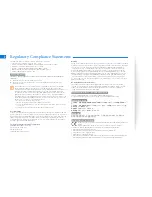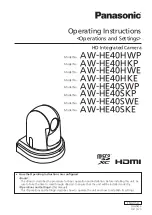
107
Using Your Camera Correctly
Power Supply and Batteries
e
Read this information and the “Safety Notes” (
➡
P.118), to make sure you use your camera
correctly.
■
Places to Avoid
Do not store or use the camera in the following types
of locations:
h
In the rain or in very humid, dirty or dusty places
h
In direct sunlight or in places subject to extreme
temperature rises, such as in a closed car in
summer
h
Extremely cold places
h
Places with strong vibration
h
Places with smoke or steam
h
Places subject to strong magnetic fields (such as
near motors, transformers or magnets)
h
In contact with chemicals such as next to rubber or
vinyl products
■
Damage by Water or Sand
The FinePix S20 Pro can be damaged on the inside
and outside by water and sand. When you are at the
beach or close to water, make sure that the camera is
not damaged by water or sand. Take care not to place
the camera on a wet surface.
■
Damage by Condensation
If the camera is carried from a cold location into a
warm place, water droplets (condensation) may form
on the inside of the camera or on the lens. When this
occurs, turn the camera off and wait an hour before
using the camera. Condensation may also form on the
media. In this event, remove the media and wait a
short time.
■
When the Camera is Not Used or is
stored Periods of Time
If you do not intend to use the camera for a long
period of time, remove the batteries and the media.
■
Cleaning Your Camera
h
Use a blower brush to brush away any dust on the
lens, LCD monitor, viewfinder or external AF sensor
and then gently wipe the camera with a soft, dry
cloth. If any soiling remains, apply a small amount of
lens cleaning liquid to a piece of FUJIFILM lens
cleaning paper and wipe gently.
h
Do not scratch hard objects against the lens, LCD
monitor screen or viewfinder.
h
Clean the body of the camera with a soft, dry cloth.
Do not use volatile substances or cleaning products
these items can cause damage.
■
Using the Camera When Traveling
When traveling overseas, do not place your camera in
the check-in baggage. Baggage can be subjected
violent shocks, and the camera may be damaged
inside or outside.
Applicable Batteries
h
In the camera, use AA-size alkaline or nickel-metal
hydride batteries.
Do not use AA-size manganese or nickel-cadmium
(Ni-Cd) batteries in your FinePix S20 Pro because
the heat created by the batteries could damage the
camera or cause is not to work.
h
The life of alkaline batteries varies between brands.
The life of batteries you purchase may be shorter
than those provided with the camera.
Notes on the Batteries
Incorrect use of the batteries could cause them to
leak, become hot, ignite or burst. Always observe the
precautions given below.
h
Do not heat the batteries or throw them into a fire.
h
Do not carry or store batteries with metal objects
such as necklaces or hairpins.
h
Do not expose the batteries to water, and keep
batteries from getting wet or stored in moist
locations.
h
Do not attempt to take apart or change the batteries,
including battery casings.
h
Do not subject the batteries to strong impacts.
h
Do not use batteries that are leaking, deformed,
discolored.
h
Do not store batteries in warm or humid places.
h
Keep the batteries out of reach of babies and small
children.
h
Make sure that the battery polarity (
≠
and
–
) is
correct.
h
Do not use new with used batteries. Do not use
charged and discharged batteries together.
h
Do not use different types or brands of batteries at
the same time.
h
If you do not intend to use the camera for a long
period of time, remove the batteries from the
camera. (Note if the camera is left with the batteries
removed, the time and date settings are cleared.)
h
The batteries feel warm right after being used.
Before removing the batteries, turn the camera off
and wait for the batteries cool down.
h
Since batteries do not work well in cold weather or
locations, warm the batteries by placing it inside
your garments before use. A battery that is not
working well due to cold will work again when the
temperature is return to normal.
h
Soil (such as fingerprints) on the battery terminals
makes the batteries charge less reducing the
number of images they will allow you to take.
Carefully wipe the battery terminals with a soft dry
cloth before loading.
If any liquid at all leaks from the batteries, wipe
the battery compartment thoroughly and then
load new batteries.
If any battery fluid comes into contact with your
hands or clothing, flush the area thoroughly
with water. Note that battery fluid can cause
loss of eyesight if it gets into your eyes. If this
occurs, do not rub your eyes. Flush the fluid
out with clean water and contact your physician
for treatment.














































